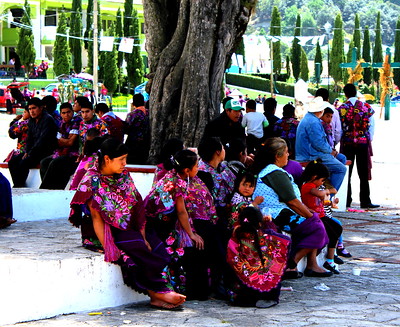 As of this writing, we’ve visited the village of San Lorenzo Zinacantán on three occasions. Like Chamula, Aldama and San Andrés Larráinzar, Zinacantán is predominately inhabited by indigenous people of Tzotzil Maya descent.
As of this writing, we’ve visited the village of San Lorenzo Zinacantán on three occasions. Like Chamula, Aldama and San Andrés Larráinzar, Zinacantán is predominately inhabited by indigenous people of Tzotzil Maya descent.
Given its relatively close proximity to the city of San Cristóbal, it (along with Chamula) is a stop on one of the most popular day trips out of the city. While the people of Zinacantán demonstrate great pride in their Maya heritage, over the years we’ve seen some examples that they seem to be embracing some less traditional aspects in their daily life.
For example; while you’re likely to have your camera or at least your memory card from your camera confiscated if you’re caught taking pictures of local people in Chamula, when you arrive at the main plaza in Zinacantán you will be approached by ladies and children dressed in the gorgeous floral themed capes the village is now famous for offering to have a photo taken…for a small fee.
Additionally, while many of the Catholic saints and icons in the main church in Chamula are dressed in traditional Tzotzil motifs, the same saints in the church in Zinacantán are more likely to be wearing robes and garb more closely associated with the Catholic Church.
We’ve gone to the village with both our favorite private guide Juan José Cruz as well as with a larger group on the Alex and Raul Tour. All three visits followed a similar pattern. First stop is the main square in the center of town and a visit to both the main church as well as a smaller chapel.
From there tour goers are taken to the home of a weaving family where they demonstrate back strap weaving as well as making corn tortillas over an open fire that they share as a snack. There is no obligation to pay for the tortillas but most people do drop a few coins on a plate to compensate the family.
At the home we visited with the Alex and Raul Tour; the family also offered samples of a very fine example of “posh” or the local home brew distilled from sugar cane that the family had made for sale. Coincidentally, there were a large number of Dutch tourists on that tour who found the cinnamon flavored version of posh remarkably similar to Goldschlager Cinnamon Schnapps and they loaded up on plastic bottles of the spirt as a takeaway from the visit.
All the females in the family from young girls to a 20-something young lady at the loom to her nearly deaf grandmother who was selling bracelets were involved in the different family businesses (serving hot tortillas, distilling posh and weaving).
Zinacantán is situated in a valley ringed by higher mountains. As you approach the valley the most predominate structures across the landscape are large commercial greenhouses witnessing Zinacantán’s position now as one of the leading flower producing villages in Mexico.
Over the past 25-years; the dominate pattern of the weaving in Zinacantán has shifted from a very simple vertical stripe to a colorful floral pattern (more likely than not having a sparkle element) as a tribute to the economic impact the flower industry has had on the village. Today, virtually every women and girl and some men wear the floral pattern a daily basis and Zinacantán weavings are highly desirable not only in San Cristóbal but all over Mexico and are attracting a lot of attention in the US and European fashion centers.
The local people in Zinacantán describe themselves as the “People of the Bat” and bats are another common theme in decorations on clothes and in gardens.



